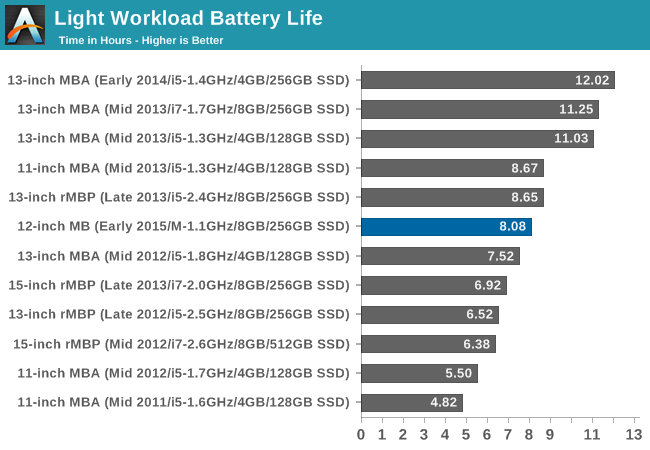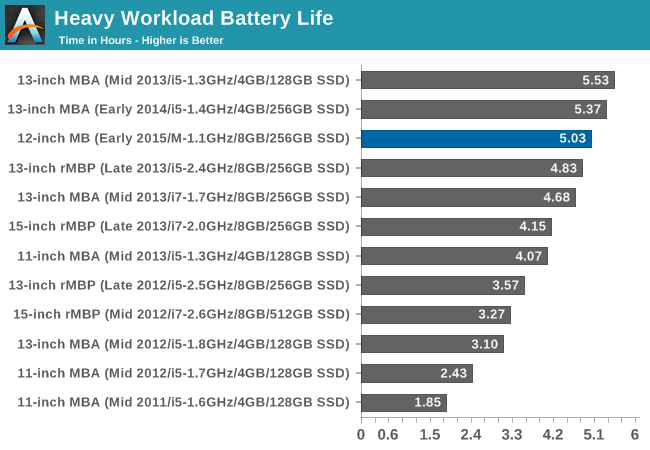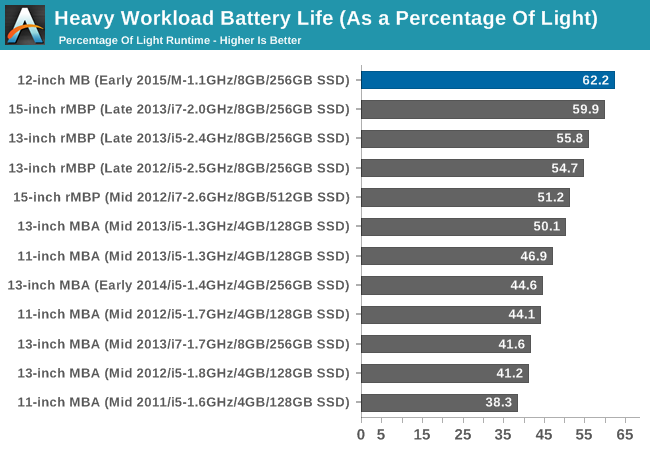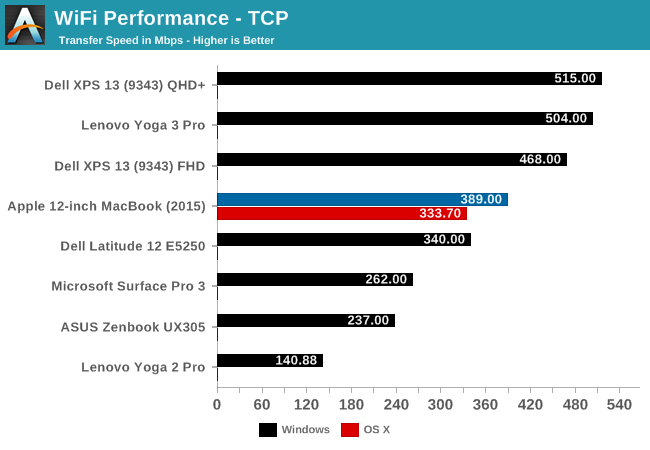The 2015 MacBook Review
by Ryan Smith on April 14, 2015 10:15 AM ESTBattery Life & WiFi Performance
Last but certainly not least in our look at the MacBook is a look at its battery life and WiFi performance.
Along with the technical considerations that have gone into making the MacBook as small as it is, I would consider the subject of battery life to be the second most interesting aspect of the MacBook’s design. For on the one hand, the CPU at the heart of this laptop is Core M, a very low power CPU specifically designed for thin & light devices, which on its own doesn’t draw all that much power. On the other hand in constructing the MacBook Apple has ditched the MacBook Air’s standard DPI TN panels for high DPI Retina IPS panels. As we’ve seen in other Apple products in the past, going Retina incurs a significant power cost, as the high DPI displays require a much stronger, much more power hungry backlight to light up the display. Apple needs only to pay this cost once, but it’s an expensive cost.
All the while Apple also has to deal with the battery capacity limits of such a small chassis. Using terraced batteries has allowed Apple to maximize the amount of volume the MacBook’s batteries occupy, however at 39.7Wh this only gets them up to roughly where the 11” MBA (38Wh) already sat. The end result is that relative to the 11” MacBook Air Apple has virtually the same battery capacity to drive a less power-hungry CPU and logic board paired with a more power-hungry display.
Officially the MacBook should be able to hit 9 hours of runtime on a light web workload, and 10 hours with video playback. This happens to be identical to what the 11” MacBook Air is rated for, and in practice would be very close to what the Haswell-based 11” Airs hit as well.
Meanwhile to test battery life, we have two workloads. Our light test is light web browsing, and our heavy test increases the number of pages loaded, adds a 1 MB/s file download, and has a movie playing. We set all displays to 200 nits.

In practice what we find is that by our testing methodologies the MacBook falls about an hour short, clocking in at 8 hours and 5 minutes. The difference in battery life most likely comes down to differences in how we test; Apple bases their estimates on 75% display brightness, whereas we test at 200 nits, which in the case of the MacBook is around 85% brightness. If we turned our brightness down to 75% I suspect our results would come very close to Apple’s, at the cost of dropping below 200 nits of brightness.
Even by our own testing standards, the MacBook’s battery life is enough to get the laptop through an entire work day (8 hours) – if only just – so while we can’t hit 9 hours at our preferred brightness Apple isn’t in too poor of a position for such a small laptop. In practice what this means is that the MacBook does just a bit worse than the 11” MacBook Air, essentially falling behind by 40 minutes of runtime. However given the fact that the MacBook is also physically smaller than the 11” Air, this is not an unexpected tradeoff.
Putting things in a bit larger perspective, thanks to Intel’s massive energy efficiency gains from Haswell in 2013, the MacBook looks very good compared to the older 2011/2012 11” MacBook Air models. From a battery life perspective the new MacBook easily exceeds those models, is physically smaller than those models, and all the while delivers performance that at worst is equivalent and at best better than those models. Put another way, Apple has been able to hold performance constant while bringing down both the size and greatly improving the battery life.
However if you want better than 8 hours on a light workload, then even the MacBook is no substitute for a larger laptop with a bigger battery. There’s only so much that can be done on 39.7Wh, and as a result the 13” MacBook Air will remain unmatched as Apple’s long-haul Ultrabook.

Meanwhile with a heavy workload the MacBook’s fortunes improve. No longer just in the middle of the pack, at 5 hours and change it’s offering runtimes close behind the 13” MacBook Airs. This shift in relative performance is not unexpected, and is closely tied to the balance between CPU power consumption and display power consumption. Compared to the light workload, the heavy workload requires that the CPU draw quite a bit more power all the while the amount of power drawn by the display is virtually unchanged. As a result the higher powered MacBook Airs see a big step up in their power requirements, while the Core M equipped MacBook sees a smaller step up.

In fact if you look at heavy workload runtime as a percentage of light workload runtime, the 2015 MacBook has the smallest drop in runtime out of all of the MacBooks. Apple’s latest laptop gets 62.2% of its light runtime under the heavy workload, compared to 50.1% for the best MacBook Air. The only thing with a similarly small decrease are the Retina MacBook Pros, whose large, Retina displays result in a similar situation.
Somewhat paradoxically then, the MacBook looks best under a heavy workload, even though its processor is relatively slow. Ultimately this is more an intellectual curiosity than anything else, but it’s a great example of how the MacBook’s component selection has resulted in a much different power consumption balance between the display and CPU than what we’ve seen on the MacBook Airs and similar Ultrabooks. If the display isn’t the single biggest power draw on the MacBook, it’s certainly going to be a close second.
WiFi Performance
Our final benchmark is a quick glance at WiFi performance. The MacBook ships with a Broadcom 2x2:2 802.11ac solution, which means that in theory it is capable of delivering up to 833Mbps.
For our WiFi benchmark we copy a large file from a Gigabit Ethernet connected SMB file server, timing how long it takes to transfer the complete file and calculating the average. All laptops are placed within a few feet of the router to maximize their achievable bandwidth and minimize interference. For the MacBook we’ve gone ahead and run this test under both Windows and OS X, to showcase any performance differences between the two OSes.

Under Windows the MacBook hits 389Mbps, about 47% of its theoretical maximum performance. Compared to other Windows laptops this is a mixed bag, with some laptops able to hit as high as 500Mbps, and others coming up much shorter. In the case of the MacBook I suspect the all-aluminum chassis is not doing it any favors. Meanwhile performance under OS X is a bit worse at 333.7Mbps, most likely due to OS X’s less extensively optimized SMB support.
While I imagine it’s impractical from a design perspective, given the fact that the MacBook only has a single USB port, I would have liked to see a 3x3:3 solution for the MacBook to allow it to achieve better WiFi performance. Even 3x3 solutions seldom keep up with GigE in the real world, but the MacBook certainly has the SSD and processing power to handle faster speeds than what we’re seeing here.










354 Comments
View All Comments
TEAMSWITCHER - Friday, April 17, 2015 - link
The $1599 - 1.2GHz - 512GB model is ~5K, in Geek Bench 3.The "Actual Work" comment cracks me up. I have successfully done 3D web-plugin development for a major company on an 11" MacBook Air. I'm pretty sure I could have done the same thing with a 12" MacBook...probably even a little better.
milkod2001 - Monday, April 20, 2015 - link
3D web-plugin development could probably be done on entry level laptop :). By actual work i've meant working with many layers, exporting to high rez tiffs, pdf, a bit of video production on the go etc.This is not where new MAcbook will serve very well. That's for less then 5% of potential Macbook buyers though, so im sure many(including you) will be more then happy with this new Macbook.
vampyren - Thursday, April 16, 2015 - link
This is just a shitty laptop, underpowered, useless with one port.Apple should have added the screen, keyboard, touch-pad on Air and everyone would been happy.
There is a limit to how thin you can make things before they become useless.
I love my MBP and was going to get the updated Air had they added retina on it but they sadly made a useless version instead.
hummerchine - Thursday, April 16, 2015 - link
I'm constantly amazed at some of the fervid anti-Apple comments on this and other forums! This review was fantastic and right on...the best I've seen, and I've been seeking them out (AnandTech does a great job, as did this reviewer). The new MacBook is highly desirable for the right person...that would be me. I've ordered the best, most tricked-out model. Is it a desktop replacement? It was not intended to be! If you want a desktop with more power, or even a portable with more power...Apple and many other companies offer many other options. If you want a crazy light awesome travel computer, this is as good as it gets! The complaints about performance just blow my mind. They have crammed in the best processor, screen, keyboard, trackpad, batteries, whatever you can mention into the smallest and lightest laptop human beings can currently design. And some are whining about it? Jeez...just think about what you are saying! And if you really hate Apple's operating system so bad (my personal favorite, but I can see that is personal preference) there are competing Windows products with the same technology limitations. If you are like me and like Apple's OS, just how could they have possibly made this thing any nicer? Well...they probably could have squeezed in another USB C port or perhaps a small MagSafe connector. I suppose even more RAM might have been nice. A faster processor would be nice too...but isn't the Intel Core-M the fastest processor currently available that will fit into something so small, have good battery life, and not require a fan? Come to grips with reality some of you...that review was very accurate and well done, and I can't wait to get my new laptop! The millions of buyers of these things don't have to listen to you...they vote with their wallets! Btw, I'm very pleased to also be a stockholder.kdalkafoukis - Friday, April 17, 2015 - link
Does anybody knows any real performance details like?how many open pdfs can u have for example?
or
in which kind of programms you are gonna have problems(annoying performance)?
cgpublic - Friday, April 17, 2015 - link
I checked the new Macbook at the Apple Store. I'm a marketing professional with a a 2011 MBP 15" quad-core, 2012 MBA entry-level, and a the latest Mac Mini w/i7 dual-core in my toolkit. Apple is once again ahead of the curve, which is what they can afford to do, while other manufacturers have to design to ensure they don't leave any checkboxes unchecked. Which is why companies such as Dell are who they are, and Apple is choking on cash. People will pay good money for a taste of the future, and this is the future right here.For 95% of what I do, the Macbook Core M + good WiFi signal can manage with ease. Photo-editing can be done in a pinch w/Adobe CreativeCloud. Once you pick it up, you have to have it, and everything else is yesterday's news.
If you're primarily playing games and fapping on your PC, I guess processing power and wired connectivity is a big deal, but I earn for a living, in the real world.
tecsi - Saturday, April 18, 2015 - link
Prediction: the new MacBook will shortly outsell the 11" MBA, the 13" MBA and the 13" rMBP. Why? Dramatically better than both MBAs and priced about the same when configured with 8TB RAM and 256GB SSD. Half the weight of the rMBP, cheaper and with most of the feature set of the except for CPU speed. But for those notebook users that need performance, they will jump to 15" rMBP with its max performance.tecsi - Saturday, April 18, 2015 - link
Make that 8GB RAM, not 8TBtecsi - Saturday, April 18, 2015 - link
Two items not really clearly mentioned, but one crucial and another useful via-a-via the MBAs.First, and most important, I find I can productively use the MacBook display at 1920x1280 (with SwitchResX). This offers 266% of the screen real estate of the 11" MBA, an enormous, work-changing difference.
Second, but more minor, the new MacBook's Trackpad is ~25% bigger than the 11" MBA, providing easier, more accurate cursor movement and positioning.
jameskatt - Sunday, April 19, 2015 - link
The fact that Apple's slowest Macbook has the fastest SSD performance means the next Macbook Pro 15-inch Retina Update is going to HAVE A BLAST with huge unencumbered SSD speeds. Coupled with a 2 TB size increase and hopefully 32 GB RAM and 4K screen, this bar will move up further.